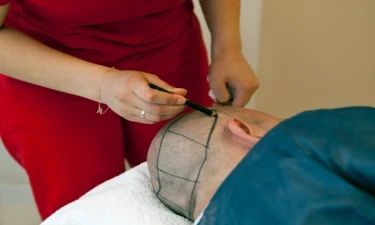

Hair transplantation offers a "permanent and natural" solution for people experiencing hair loss. Hair loss or hair loss is one of the most common problems faced by everyone, regardless of male or female. Although not in terms of health, it affects individuals negatively in terms of psychological and social life.

Hair loss in men begins to appear after puberty. Since male genetics are more suitable for hair loss, baldness problem occurs at later ages.
Although hair loss in women is rarer, it is caused by individual gene differences. Stressful life, imbalance of thyroid hormone, use of birth control pills, birth process, breastfeeding process, menopause trigger hair loss in women.
Perm, blow dryer, etc. under the name of hair care. other processes lead to excessive heat exposure of the scalp and long-term hair loss.
In general, hair transplantation can be applied to any patient with male pattern hair loss. Male pattern hair loss develops with the effect of male hormone in people who are genetically predisposed to hair loss.
In these people, the hair-producing cells around the hair follicle lose their vitality over time with the effect of this hormone. Therefore, hair; first it gets thinner, then it starts not to elongate and finally it falls out completely.
Of course, hair transplantation is the surest and most permanent form of treatment for patients with this disease. At the same time, hair transplantation can be applied to people who have a burn scar on the scalp as a result of accident or any trauma, if blood circulation is detected in that area.
Before hair transplantation, a few tests are performed to see if the person is suitable for treatment. As long as no problems are encountered in the patient's analysis results, the treatment is approved.
It is recommended that the person quit smoking, alcohol and blood thinners 1 (one) week before hair transplantation. A controlled examination of the person to be transplanted is carried out in the presence of a specialist doctor.
During the examination, it is decided which method will be applied by looking at the hair loss of the patient. After the process to be applied is determined, the drawing process of the person begins.
Then, an estimated graft calculation is made based on the adequacy status of the donor area. After these processes, the patient is ready for the operation.
The patient to whom FUE will be applied is shaved before hair transplantation. In the DHI procedure, the operation is started directly without shaving. After putting on the surgical gown, the patient is placed face down and local anesthesia is applied to the donor area.
After the hair transplantation process, all the transplanted hair follicles are shed. This is a completely normal state.
Hair follicles shed within 1-2 months begin to grow as of the 3rd month. 6 months after the transplant, 90% of the transplanted hair will come out and start to grow.
The removal of the remaining 10% may take up to 12 months, although it varies from person to person.
As a result, we can say that the result of hair transplantation is fully received at the end of 12 months.
FUE (Folicular Unit Extraction) technique is a hair transplantation method based on the transfer of hair follicles taken one by one from the nape region of the person, to areas where there is no hair. With this method, hair taken from any part of the body (such as back, chest and legs) can be transferred.
FUE hair transplantation, with its full name Follicular Unit Extraction, is the most widely used technique all over the world. With this method, the aim is to place the maximum number of follicular grafts in a short time.
In FUE hair transplantation method; hair follicles are taken one by one from the area selected as the donor area. This region usually consists of the nape region between the two ears.
The reasons why FUE technique is preferred more than other hair transplantation methods can be summarized as follows;
• There are no traces in the areas where the hair follicles used in the transfer are taken.
• Since no incision is taken from the scalp, stitches are not performed.
• Hair transplantation costs are lower than other techniques.
• At the same time, eyebrow, mustache and beard transplantation can be done with the FUE method
DHI hair transplantation technique stands for "Direct Hair Implant", that is, direct hair transplantation. The feature of DHI hair transplantation technique that distinguishes it from other techniques and makes it stand out is that, after the donor is taken, it can perform the process of opening the channel first and then placing the hair follicle in the area to be transplanted, thanks to its own special pen.
DHI hair transplantation is an application that can be easily performed under sedation. Sedation allows you to complete hair transplantation in the most comfortable way without feeling anything.
• It shortens the time that the hair follicles stay outside even if they are in a special solution, thus maximum efficiency is obtained from the hair follicles.
• Bleeding rate is at minimum level.
• When unshaven hair transplantation is preferred, DHI is the most efficient hair transplantation technique.
• Less damage, faster recovery time
• When the procedure is performed with sedation, hair transplantation is completed without you feeling anything
Depending on your hair loss, FUE or DHI technique is applied. After your hair analysis, our specialist physicians give you the necessary guidance.
Yes, anyone with a sufficient number of grafts and donor areas can have hair transplantation after hair loss.